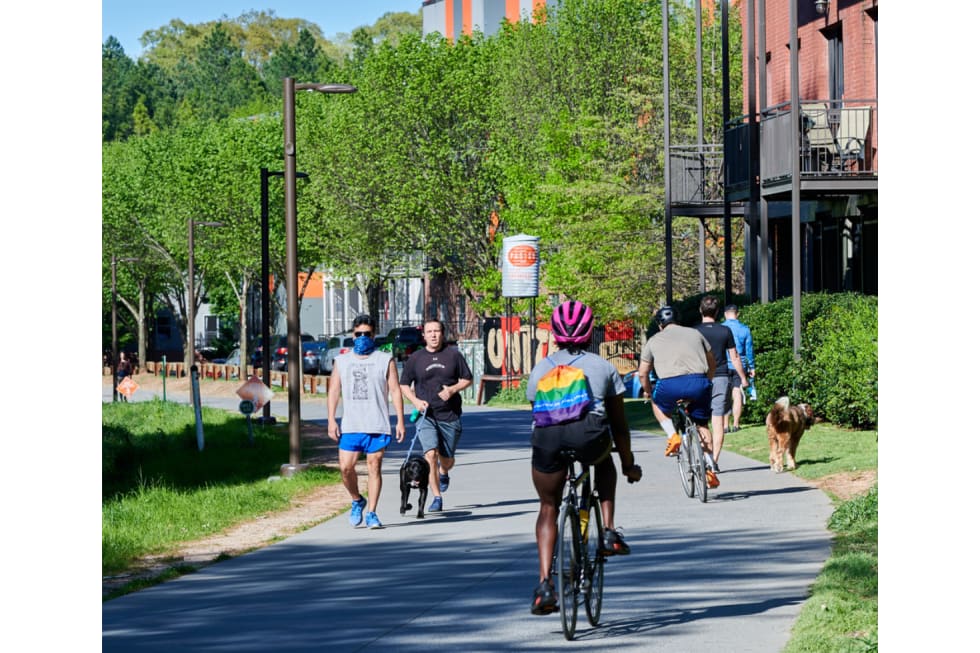The Pembroke
- 113 units available
- 1 bed • 2 bed
- Amenities
In unit laundry, Granite counters, Hardwood floors, Dishwasher, Pet friendly, 24hr maintenance + more

The best way to research a neighborhood before renting is to combine hard data and historical rent trends, local feedback, and firsthand impressions. Review safety scores, average rent prices, commute times, local amenities, and the overall community feel. Next, confirm your findings with in-person visits. A methodical approach can help you avoid surprises and make a confident, informed choice.
Here’s a strategic approach to researching a neighborhood before signing your next lease agreement.

Before diving into neighborhood research, crime maps, or community boards, check whether a neighborhood fits your apartment budget. Even in the same metro area, rents can vary dramatically between different neighborhoods. Knowing the averages helps you spot deals and avoid overpaying from the start. Here’s some of our sample data to see how average rents in major cities compare.
| City | Average One-Bedroom Rent (Mid-2025) | Average Two-Bedroom Rent (Mid-2025) |
|---|---|---|
| Dallas | $1,540 | $2,233 |
| Columbus | $1,196 | $1,523 |
| Charlotte | $1,441 | $1,694 |
Try comparing our inventory of neighborhood rents to the citywide average. If the price is far above average, it should also offer strong benefits, like lower crime rates, better schools, nearby amenities, or a shorter commute. Otherwise the apartment probably doesn’t justify the cost.
You can pull from our combination of:
For example, you can create a spreadsheet with the cities you’re interested in. Then, browse our active neighborhood rental listings for New York and Austin to compare rents.
You can also view our most up-to-date New York and Austin’s rent reports to see the median rents, year-over-year rents, and comparison of one and two bedroom rents.
If you want to dig a little deeper, you can also look at our cost of living articles on New York and Austin. With all of these resources combined, you’ll have more clarity on how to compare the cost of living and lifestyles in different cities.
Rent is only part of the picture. Utilities, groceries, transportation, and healthcare can quickly change a neighborhood’s affordability. Use data-driven tools to estimate these costs before you sign a lease.
For example, newer, energy-efficient buildings may save you money on utilities, while areas with better transit access can lower transportation expenses. Factoring in all these expenses ensures you choose a neighborhood that’s truly within your budget.
Helpful cost-of-living resources:
A neighborhood that seems affordable in rent alone can quickly become costly if you overlook the full cost-of-living picture. Here are some of our latest Cost of Living articles on different cities to help you get started on your search.
Price stability is one of the most overlooked factors when choosing a neighborhood. Even if an area is affordable now, steep year-over-year rent hikes can make it unsustainable within a lease or two. Here’s an example of some of the latest data trends we’ve seen.
| City | Average One-Bedroom Rent (Mid-2025) | YoY Change | Rent Stability Score (1–10) |
|---|---|---|---|
| Dallas, TX | $1,540 | +2.8% | 7 |
| Columbus, OH | $1,196 | +1.5% | 8 |
| Charlotte, NC | $1,441 | +3.6% | 6 |
High YoY rent growth (above 5%) often signals rising prices due to gentrification or new development. If you’re choosing between two areas with similar rents, the one with less volatility may save you more in the long run. Our city, state, and national rent reports are regularly updated to give you the data you need to see the latest rental trends.
Safety is a top concern for most renters, but crime rates can vary widely within the same city. Compare violent and property crime data to citywide averages, and remember that low crime doesn’t always equal high rent.
Helpful safety research tools:
After reviewing the data, verify in person. Walk the streets during the day and at night, paying attention to lighting, foot traffic, and overall upkeep.
A “poor” crime grade doesn’t automatically make an area unsafe for everyone. Some ratings are driven by non-violent property crimes, like bike theft, that may be avoidable. Others are influenced by incidents in nearby entertainment districts, far from residential areas.
We also regularly update our data-driven series on safest neighborhoods for renters. Get started with “What Are the Safest Columbus Neighborhoods for Renters in 2025? (Crime & Rent Data) and 9 Safest Philadelphia Neighborhoods for Renters in 2025 (Crime & Rent Data).”
Remember, if a neighborhood has benefits like a short commute or solid amenities, look deeper. Use block-level data, talk to residents, and weigh whether the risks are manageable.
You can do apartment research on a building’s reputation with online reviews and resources. Start by reading our round-up of reviews at Apartment List and comparing them to feedback on other rental review sites. Search for patterns in complaints (“roaches in multiple units,” “poor lighting in parking areas,” “slow to respond to maintenance”). You can also check your city or county housing department’s inspection reports, which may be public online.
Even if a neighborhood passes your research, the building itself can make or break your renting experience. Some properties have a history of recurring problems. Mold, pest infestations, broken elevators, or inadequate security aren’t always obvious during a quick apartment tour.
You can check Google Maps and public transportation maps to get an idea of commute times and routes. Even the perfect apartment can lose its appeal if the commute is stressful. Make sure to check peak travel times. If you rely on public transportation, look for proximity to major bus or rail lines.
WalkScore is the go-to resource to find a neighborhood with good walking, biking, and transit scores. Google Maps, Strava Heatmap, and Local DOT or planning department maps are also useful resources.
Walkability and bikeability can make daily life more convenient, healthier, and even more affordable. A highly walkable neighborhood lets you run errands, grab groceries, and reach entertainment without relying on a car, while bike-friendly areas offer safe lanes, storage, and routes that connect to key destinations.
Get our latest articles on the Best Walkable Neighborhoods for Renters:
Beyond lifestyle preferences, walking and biking can save on transportation expenses and support a more active lifestyle.

Yes, you should research schools because they impact property values and rental demand. High-rated schools tend to attract long-term residents, which supports neighborhood stability. Use a resource like GreatSchools.org to check academic performance, extracurricular offerings, and community involvement.
Browse our articles on our Best Neighborhoods for Families series:
By factoring in school quality, you’ll make a more informed choice about where to rent and boost your chances of landing in a neighborhood that holds its value.
Yes, neighborhoods near colleges and universities often have their own distinct rhythm. Expect a mix of students, faculty, and long-term residents, along with coffee shops, affordable eats, live music, and cultural events. Rental options here may include short-term leases, furnished units, and older homes converted into apartments, which can mean flexibility and budget-friendliness.
Off-campus apartments also come with trade-offs. Higher turnover means neighbors may change frequently, and seasonal demand can cause rent spikes at the start of each semester. Weekend noise, parking competition, and heavier traffic during school events are common considerations.
Amenities shape your day-to-day experience. Look for grocery stores, parks, gyms, and entertainment options within walking or biking distance. If nightlife is important, check bar and restaurant density, plus late-night transit availability.
Get our latest articles on the best neighborhoods for every lifestyle.
We look at rental data, crime grades, transit scores, diversity ratings, and a rundown of who each neighborhood is best for.
If you have pets, check to see if the neighborhood has pet-friendly apartments, nearby parks or dog runs, and access to veterinary care. Some areas even host pet-friendly events that can help you and your furry friend feel at home faster.
Even if a neighborhood looks perfect on paper, there are some signs to watch out for:
Spotting the warning signs early can help you avoid unpleasant surprises and trying to break your lease.
Yes, join neighborhood Facebook groups, browse Nextdoor discussions, and chat with people in coffee shops or parks. Locals can provide insights you won’t find in data, including noise issues, traffic patterns, or hidden neighborhood gems. Asking residents coming out of their apartment buildings or for referrals from friends and family can also help get honest feedback.
Yes, data is valuable, but your own impression matters most. Visit at different times of day, observe the atmosphere, and see if it matches your lifestyle. If something feels off, trust that instinct.
Following this checklist ensures you’ve examined every major factor that affects your quality of life and long-term satisfaction in a rental.
Researching neighborhoods before renting requires the right data with real-world experience. From comparing rents to evaluating safety and lifestyle fit, each step helps you make a choice you won’t regret.
Ready to find an apartment that checks all your boxes? Take the quick Apartment List quiz to narrow your search. In five minutes, you’ll save 50 hours of searching.
The first step in researching a neighborhood before renting is starting with rent and cost-of-living data. Compare the neighborhood’s average one-bedroom and two-bedroom rents to the citywide median, then factor in utility deposit, move in fees, and costs and rent stability to make sure it’s affordable long-term.
Check to see if a neighborhood’s rent will keep going up by reviewing historical rent trends and rent stability scores. A high year-over-year rent increase (above 5%) often signals a risk of continued price hikes due to gentrification or development.
The best way to check neighborhood safety is to use tools like CrimeGrade.org, NeighborhoodScout, and local police department crime maps to compare violent and property crime rates to city averages. Follow up with in-person visits during the day and at night.
Yes, sometimes low grades reflect non-violent property crimes or incidents concentrated in commercial zones. Look at block-level data, talk to residents, and see if the risks are ones you can manage.
See if an apartment building has hidden issues by reading our reviews, and check city inspection reports for signs of recurring problems like mold, pests, or broken security systems. Talking to current tenants can reveal issues you won’t see during a tour.
The best way to check commute times before moving is by using Google Maps or your city’s transit app to test morning and evening commute times for your preferred travel mode. If you rely on transit, confirm access to major lines and connections.
Yes, you should care about school ratings. Strong schools often increase neighborhood stability, property values, and community engagement, which benefits all residents.
Start by researching nearby grocery stores, parks, gyms, and entertainment. If nightlife matters, check bar and restaurant density, plus late-night transit availability. Visit at different times of day to get a feel for the vibe.
Look for pet-friendly apartment listings, dog parks, walking trails, and nearby veterinary services. Local Facebook groups and Instagram pages can also let you know about pet-friendly community events.
Some of the biggest red flags before signing a lease include sudden rent spikes, high turnover, poor lighting, empty storefronts, and outdated building amenities. These can indicate safety issues or poor property management.
Get honest opinions by joining neighborhood Facebook groups, browsing Nextdoor threads, and striking up casual conversations at local coffee shops or parks to hear what residents really think.

In unit laundry, Granite counters, Hardwood floors, Dishwasher, Pet friendly, 24hr maintenance + more
In unit laundry, Patio / balcony, Granite counters, Pet friendly, Stainless steel, Walk in closets + more